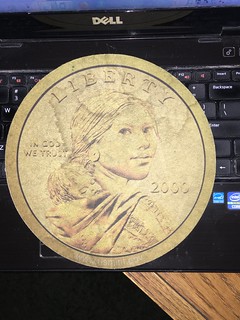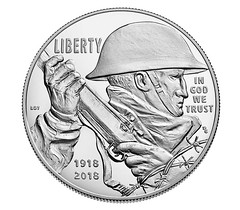
PREV ARTICLE
NEXT ARTICLE
FULL ISSUE
PREV FULL ISSUE
NOTES FROM E-SYLUM READERS: MARCH 25, 2018The Five Elizabeth Queens of England 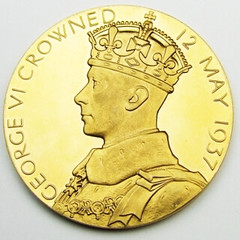 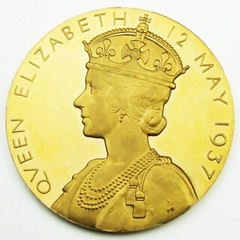 Philip Mernick of London writes: When you showed the beautiful gold 1937 coronation medal you said “No, not THAT Queen Elizabeth, the first one. “ Readers might find it interesting that Elizabeth Bowes-Lyon wife of George VI was in fact the fourth of five Elizabeth Queens of England. Only two have been Queen in their own right Elizabeth I (1558-1603) and Elizabeth II (from 1952) but three others have been Queen by marriage. Elizabeth Woodville wife of Edward IV, Elizabeth of York, wife of Henry VII and the aforementioned Elizabeth Bowes-Lyon wife of George VI. So who came before Elizabeth the second? Um, Elizabeth the first? Nope - it's not so simple (it rarely is), and thanks to Philip for setting me straight. I should consult Dr.
Google far more often in such cases, but I guess I'm clinging too hard to the use of my own fool head, whom I shall now begin calling "Dr. Noodle." As my wife would be happy to tell
anyone, without any prompting whatsoever, that's another dumb idea. -Editor
To read the earlier E-Sylum article, see: Howard Daniel's Vietnamese Money Wallet 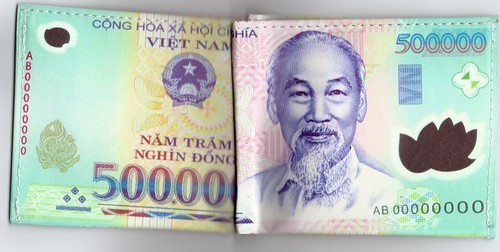 Howard Daniel writes: Several years ago, many young Vietnamese numismatists asked me to create a Facebook page. I really did not want to do it but they wanted me to post my new information/pieces there so they could learn about them. After a little more nudging, I agreed and signed up. Within a month or so, I had several hundred Vietnamese numismatists as my friends! I was shocked. Now I have well over 1000. Now these new young numismatists post more information/pieces than I have time to do. During my recent two months in Viet Nam I stayed at Sedona Suites above the large Saigon Centre Mall in District 1 in Ho Chi Minh City. While going through the more recent posts from my friends, I spotted one entry with a 500,000 Dong bank specimen note in color as the design across an entire wallet. I asked the young man where I could buy it and he told me he would give one free to me if I came downstairs in about 30 minutes and stood outside the mall entrance on Pasteur street. I agreed and he appeared and gave me the wallet. I tried to pay him for it but he refused and took off on his motorcycle. The design is what is used by the State Bank of Viet Nam and is not a specimen available to collectors. Later, the young man sent me many images of other wallets with paper and polymer notes on them, to include a US 100 Dollars note. They are professionally done and can actually be used as a wallets but I have put mine in my Socialist Republic of Viet Nam collection. Very cool. Thanks!
More on the Origin of the Word "Znachki" I have a further comment about the Russian word "znachki" referenced in The E-Sylum. The word "znachki" is the plural of "znachok", which means both "mark" and "badge". And "badge" would be the translation when refering to these Soviet tinnies. It is probably linguistically related to the word "znak", meaning "sign", as the writer notes in the E-Sylum comment. (Source Smirnitzky's Russian-English Dictionary.) Thank you! Makes sense. -Editor
To read the earlier E-Sylum article, see: More on Obsolete Computer Files Please let me introduce myself. My name is Levin Messick and I have been a collector of obsolete banknotes since 1954. My area of interest is Maryland. I was a contributor to Denwood Kelly's book Money and Banking in Maryland and most recently the editor of volume 8 Maryland notes for Dave Bower's Obsolete Paper Money series. I also collect ancient coins and have most of the Roman Emperors and many of their wives except for the last few bums of the month from 455-476. I also have a nice selection of Greek and Bactrian coins. As an ANA member I want you to know how great it is to be able to receive your publication. You do a singular job in bringing together a publication that I avidly await to see what is next. I must say that I believe books are not going away soon. While our digital age is a marvel it is transient. Computer wonkies just don't get that the past needs to be preserved; they can only see what is in front of them. I worked many years as a trust appraiser and discovered early on that when I needed to go back more than a year's worth of property sales that they had been dumped by the computer folks. When I called to complain a bright young fellow said "Why would you possibly want that old stuff"? My reply was I did not need it for me but the IRS did and if they could not retrieve the information it could cost my client several millions of dollars. Said client might then take out his ire on them. So, I found the article on the recovery of information on old discs of more than passing interest. Martin Purdy of New Zealand writes: In the 1970s and early 80s I made a card index file for all my coin purchases, which worked well for a few years, though it started to grow pretty big in the end. In the mid-1980s I lived in Japan while my card index (and coins) stayed in New Zealand. I bought a new-fangled word-processor while there (one that showed about three lines at a time on its mini-screen but allowed files to be saved, printed and stored to 3.5" disk). You can see where this is heading - I logged all my new purchases on the new machine and saved it all to disk, and when I came home I laboriously transcribed all the old cards onto data files on disks, then burned the cards. Of course, the file system was maker-specific (Toshiba?) and the disks can't even be opened on a Windows system. I still have the disks, 30 years later, and realistically, any information on them will be totally out of date now and not worth going to any expense over. But a lesson learned, all the same ... I think! My numismatic and book lists are all on generic Excel files now (no more proprietary tools for me), and I hope I can at least transfer them to any successor program in good time if the need should ever arise. I had a card file for my own collection and (luckily, I suppose) never put it in computer format. After I sold the bulk of that collection I got rid of the cards. Sometimes I
wish I still had the information, though. -Editor
To read the earlier E-Sylum article, see: On the Purported 16th Century Coin Cabinet 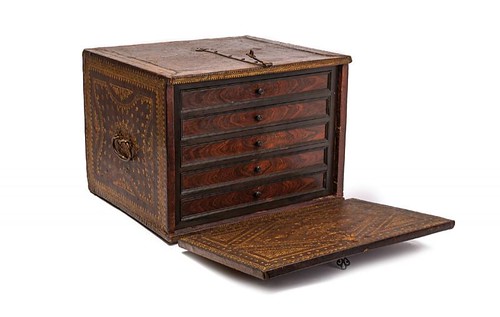 Regarding the purported 16th century coin cabinet, Arthur Shippee of Hamden, CT writes: This looks a lot like the mah-jongg cabinet mother had, doesn’t it? Without positive evidence of the contents, I don’t see how we can deduce its particular function. His brother Bob Shippee of Colorado Springs, CO adds: Yes, it looks a bit like our mother's mahjong cabinet, but it's clearly not Chinese, so I suspect it had a different use. I agree with Wayne -- the drawers look too thick to be used for coin storage. My guess is it's a jewelry box. Thanks, guys. -Editor
To read the earlier E-Sylum article, see: Another Sacajawea Mouse Pad I have not yet retired my United States Mint 2000 Sacajawea mouse pad. She continues to guide me through the wilderness of various writing projects. And I thought mine had seen better days! Donn's SacPad marches on toward the longevity record. -Editor
To read the earlier E-Sylum article, see: The 2018 WWI Centennial Dollar Design Questioned I enjoyed the information about the process of selection of commemorative coins for the American Legion. They as a group have helped me to gain recognition of my service connected disabilities after years of stonewalling by the VA. They are a great organization and most deserving of the honor.
Another way of looking at this is that lefty diners are generally seated at the top left and bottom right seats so that they don't bang elbows with fellow diners. You don't get preferred seating in a trench. Imagine banging elbows while loading, cocking, and firing rifles under fear and stress! Maybe the artists at the mint and the Commission of Fine Arts should consult with a military person when designing such coinage. Readers of the regular Sunday night E-Sylum did not see the U.S. Mint ad Mr. Messick refers to; there are different ads in the ANA Edition which goes to American
Numismatic Association members. Follow the archive link below to see it. -Editor
To read the earlier E-Sylum article, see: French Issues in the East Indies One of your Numismatic Nuggets of January 14, 2018 is a piece I have put on page 187 of my upcoming 3rd edition of French Southeast Asia Coins & Currency catalog, which will be printed this month. The many French coins and paper money issues in the East Indies are not often cataloged and they are in my catalog for the first time. It was a major oversight of mine not to include them in the earlier editions. 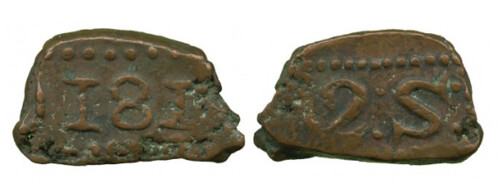 Batavia, under French rule, copper bonk 2 stuivers, 1810, 6.31g (Sch 569). Glad to help! We'll look forward to the new edition. -Editor
To read the earlier E-Sylum article, see: THE BOOK BAZARREWayne Homren, Editor The Numismatic Bibliomania Society is a non-profit organization promoting numismatic literature. See our web site at coinbooks.org. To submit items for publication in The E-Sylum, write to the Editor at this address: whomren@gmail.com To subscribe go to: https://my.binhost.com/lists/listinfo/esylum All Rights Reserved. NBS Home Page Contact the NBS webmaster 
|
